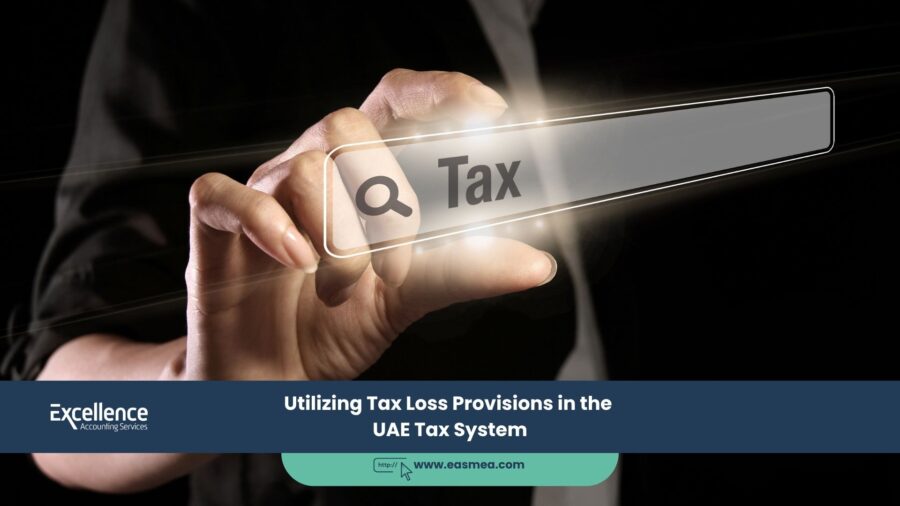Utilizing Tax Loss Provisions in the UAE Tax System
In the world of business finance, the term “loss” often carries a negative connotation. However, within a structured tax system, a loss can be transformed from a sign of a challenging period into a valuable strategic asset. The UAE Corporate Tax law, in its sophisticated design, recognizes this by incorporating robust provisions for the treatment of tax losses. These rules are not just a technical footnote; they are a critical component of the legislation that provides financial relief, encourages business resilience, and influences major strategic decisions, from M&A to corporate structuring.
- Utilizing Tax Loss Provisions in the UAE Tax System
- Part 1: The Anatomy of a Tax Loss
- Part 2: The Carry-Forward Mechanism - How It Works
- Part 3: Critical Conditions and Restrictions
- Part 4: Tax Losses in M&A and Restructuring
- Part 5: Tax Groups - The Superior Strategy for Loss Relief
- What Excellence Accounting Services (EAS) Can Offer
- Frequently Asked Questions (FAQs) on Tax Losses
- Transform Tax Losses into a Strategic Advantage.
For business leaders and finance professionals, understanding how to utilize tax losses is not merely about damage control. It is about strategic foresight. A tax loss incurred in one year can be carried forward to reduce taxable profits in future, more prosperous years, directly lowering a company’s cash tax liability. This mechanism effectively allows the government to share in the downside of a business cycle, not just the upside. This definitive guide explores the mechanics, conditions, and strategic implications of the UAE’s tax loss provisions, providing a roadmap for businesses to turn today’s losses into tomorrow’s tax savings.
Key Takeaways on UAE Tax Loss Provisions
- Losses as Assets: Tax losses can be carried forward indefinitely to offset future taxable profits.
- The 75% Rule: The amount of tax loss used in a year cannot exceed 75% of the taxable income for that year.
- Ownership Continuity is Key: A change in ownership of more than 50% can lead to the forfeiture of tax losses, with certain exceptions.
- No Time Limit: Unlike many tax jurisdictions, the UAE currently imposes no expiry date on carried-forward tax losses.
- Tax Groups Offer an Advantage: Forming a Tax Group allows for the immediate offset of losses from one member against the profits of another.
Part 1: The Anatomy of a Tax Loss
It is fundamentally important to distinguish between an ‘accounting loss’ and a ‘tax loss’. An accounting loss is what appears on your Income Statement (Profit & Loss account), calculated according to International Financial Reporting Standards (IFRS). A tax loss, however, is a specific calculation for tax purposes.
A tax loss arises when a business’s total tax-deductible expenses for a financial period are greater than its total taxable income for the same period. The calculation starts with the accounting profit/loss and is then adjusted for tax-specific rules:
- Non-Deductible Expenses: Certain accounting expenses (e.g., specific fines, 50% of client entertainment costs) are added back.
- Non-Taxable Income: Income that is exempt for tax purposes (e.g., dividends from a qualifying participation) is deducted.
If the final figure is negative, that amount is the “Tax Loss” for the period. Accurate accounting and bookkeeping is the essential foundation for this calculation.
Part 2: The Carry-Forward Mechanism – How It Works
Article 37 of the Corporate Tax Law allows businesses to carry forward a tax loss incurred in one tax period and set it off against the taxable income of subsequent periods. This is the core of the tax loss relief system. However, there is a crucial limitation.
The 75% Restriction
While losses can be carried forward indefinitely, the amount you can use in any single profitable year is capped. You can only offset up to 75% of your taxable income for that year with the brought-forward losses. The remaining 25% of the profit will be subject to the 9% Corporate Tax. Any unused losses can be carried forward to the next year.
Example:
- Year 1 (2024): Company A has a Tax Loss of AED 2,000,000.
- Year 2 (2025): Company A has a Taxable Income of AED 1,000,000.
- Calculation for Year 2:
- Maximum loss to be used: 75% of AED 1,000,000 = AED 750,000.
- Taxable income after loss relief: AED 1,000,000 – AED 750,000 = AED 250,000.
- Corporate Tax Payable: 9% of AED 250,000 = AED 22,500.
- Remaining Loss to Carry Forward: AED 2,000,000 – AED 750,000 = AED 1,250,000.
This rule ensures that profitable companies contribute some tax revenue each year, while still providing significant relief.
Part 3: Critical Conditions and Restrictions
The ability to use tax losses is not unconditional. The law includes specific provisions to prevent abuse, primarily revolving around the change of ownership.
The Continuity of Ownership Rule
This is the most significant restriction. If there is a change of more than 50% in the ownership of the company from the end of the loss-making year to the end of the profit-making year, the right to use those historical losses is forfeited.
The Exception: Same or Similar Business
The law provides a crucial exception to the ownership rule. Even if ownership changes by more than 50%, the losses can still be used if the new owner continues to conduct the same or a similar business as the one that incurred the losses. This is designed to support genuine business takeovers where the underlying commercial activity continues. Defining “similar” can be complex and requires careful business consultancy and legal analysis.
Other Key Restrictions
- Exempt Income Activities: Losses from an activity that generates exempt income (e.g., from a qualifying shareholding) cannot be used to offset profits from a taxable activity.
- Pre-CT Law Losses: Losses incurred before the business was subject to Corporate Tax cannot be carried forward.
Part 4: Tax Losses in M&A and Restructuring
For a CFO or an M&A team, a target company’s tax losses can be a significant hidden asset, potentially reducing the post-acquisition tax burden. However, this requires rigorous due diligence.
The Due Diligence Checklist for Tax Losses:
- Validate the Losses: Are the losses accurately calculated? Have they been verified by an external audit?
- Trace Ownership History: Has there been a >50% ownership change since the losses were incurred? This requires a detailed review of the share register.
- Assess Business Continuity: If ownership has changed, is the current business the same or similar to the one that generated the losses? Document this continuity.
- Valuation Impact: The potential future value of these tax savings should be factored into the business valuation of the target company.
A comprehensive due diligence process is non-negotiable when tax losses are a material part of the deal.
Part 5: Tax Groups – The Superior Strategy for Loss Relief
While carrying forward losses is a valuable tool for a standalone company, forming a Tax Group offers a far more immediate and powerful advantage. When companies form a Tax Group, they are treated as a single taxable person.
This means that a tax loss incurred by one member of the group in a given year can be immediately set off against the taxable profits of another member in the very same year. This eliminates the need to carry the loss forward and wait for the loss-making entity to become profitable. This instant relief improves group-wide cash flow and reduces the overall tax liability immediately.
What Excellence Accounting Services (EAS) Can Offer
Navigating the complexities of tax loss utilization requires expert financial and tax guidance. At EAS, we help businesses transform their tax losses from a historical record into a strategic financial asset.
- Strategic Tax Planning: Our UAE Corporate Tax experts can model the most effective use of your tax losses and advise on corporate structures, such as Tax Groups, to maximize relief.
- M&A Advisory and Due Diligence: We conduct thorough tax due diligence on target companies to validate their tax loss position and ensure you can utilize them post-acquisition.
- Financial Reporting for Tax Compliance: We ensure your financial reporting is robust and IFRS-compliant, providing the necessary foundation to accurately calculate and defend your tax loss claims.
- CFO Services: Our part-time CFO services can help you integrate tax loss forecasting into your company’s financial planning, budgeting, and valuation models.
Frequently Asked Questions (FAQs) on Tax Losses
An accounting loss is based on IFRS and includes all revenue and expenses. A tax loss starts with the accounting loss but is adjusted for tax law. For example, you add back expenses that are not tax-deductible (like certain fines) and subtract income that is tax-exempt (like a qualifying dividend). The result is the tax loss, which is the only figure that can be used for tax relief.
No. You can only use carried-forward losses to offset a maximum of 75% of your taxable income in a given year. The remaining 25% of your profit for that year is taxable at the standard 9% rate. This ensures a predictable, minimum level of tax revenue for the government from profitable companies.
Since the ownership has changed by more than 50%, you will lose the right to use those historical tax losses. However, there is a crucial exception: if the company continues to carry on the *same or a similar business* after the sale, the losses can still be carried forward and utilized by the company under its new ownership.
Currently, under the UAE Corporate Tax Law, there is no time limit. You can carry forward your tax losses indefinitely until they are fully utilized, subject to the annual 75% restriction and the ownership conditions.
t
This is complex. If you have a mainland business (taxable at 9%) and a separate Free Zone entity that is a Qualifying Free Zone Person (QFZP) (taxable at 0% on Qualifying Income), you cannot consolidate them. The losses from the mainland entity cannot be used to offset the Qualifying Income of the QFZP. If the QFZP also has non-qualifying income taxed at 9%, then specific rules for tax groups or other reliefs may apply.
While the law mandates audited financials for all businesses (unless a specific exemption applies), it is particularly crucial when claiming losses. The FTA will require a robust, verifiable basis for the loss calculation. Audited, IFRS-compliant financial statements, supported by a detailed tax computation, are the best evidence you can provide. A simple accounting review may not be sufficient.
Generally, no. The law does not allow for the carry-forward of losses incurred before a business’s first tax period under the new regime. The slate is wiped clean, and only losses incurred from your first tax period onwards are eligible for relief.
Within a Tax Group, the process is much more efficient. If Company A has a profit of AED 500,000 and Company B has a loss of AED 300,000 in the same year, the group’s net taxable income is simply AED 200,000. The loss is used immediately and in full, bypassing the 75% carry-forward restriction that would apply if they were separate entities.
You need to maintain:
- Fully audited IFRS financial statements for the year the loss was incurred.
- A detailed tax computation showing the adjustments from accounting loss to tax loss.
- A continuously updated schedule tracking the tax loss balance carried forward each year.
- Share register and legal documents to prove continuity of ownership.
A modern system like Zoho Books is vital for maintaining this data integrity.
No. Tax losses are specific to the legal entity that incurred them. If a company is liquidated, its tax losses are extinguished and cease to exist. They cannot be transferred or sold to another entity, which is why preserving the legal entity through a sale (rather than an asset transfer) is important if the losses are to be utilized.
Conclusion: The Strategic Management of Tax Losses
The UAE tax system’s provisions for loss relief are a clear signal of a mature and resilient legislative framework. They offer a vital lifeline to businesses navigating economic cycles and provide a powerful incentive for investment and restructuring. For CFOs and business leaders, the message is clear: tax losses are not a liability to be written off, but a valuable asset to be carefully managed. Through meticulous record-keeping, strategic corporate structuring, and forward-looking financial planning, a business can ensure that the challenges of today directly contribute to the profitability and tax efficiency of tomorrow.




